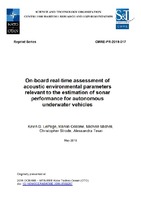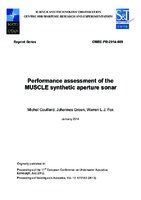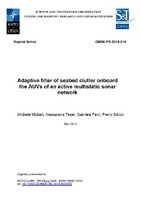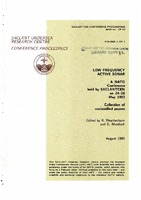| dc.contributor.author | LePage, Kevin D. | |
| dc.contributor.author | Oddone, Manlio | |
| dc.contributor.author | Micheli, Michele | |
| dc.contributor.author | Strode, Christopher | |
| dc.contributor.author | Tesei, Alessandra | |
| dc.date.accessioned | 2019-06-14T14:36:54Z | |
| dc.date.available | 2019-06-14T14:36:54Z | |
| dc.date.issued | 2019/05 | |
| dc.identifier.govdoc | CMRE-PR-2019-017 | en_US |
| dc.identifier.uri | http://hdl.handle.net/20.500.12489/758 | |
| dc.description.abstract | CMRE is evaluating the use of autonomous robots for the detection and tracking of underwater targets. Robotic detection and localization comes with many challenges, not the least of which is the requirement to maximize the probability of detection of targets while minimizing the rate of false alarm. In order to do this, underwater robots performing detection and localization will require some form of on board decision engine to guide their trajectories while performing their missions. Many of the autonomy frameworks for determining these trajectories being developed at CMRE are based on a comprehensive model for multistatic active performance called the Multi-Static Tactical Planning Aid, which predicts how the probability of detection of underwater targets varies in complex environments with range dependent sound speed profile and bathymetry. However, there are residual parameters of the model, such as bottom scattering strength and bottom loss, which must be tuned in order for MSTPA to provide predictions which are in accordance with the actual sonar performance being observed by the robot. In response to this need, a client-server version of MSTPA, MSTPA Lite, has been streamlined for application of embedded processors on the robots, and additional data products for the comparison of MSTPA Lite with observations have been added to the on-board real-time signal processing. With these modifications it is now possible for the robots to update the MSTPA Lite model in-mission to provide better agreement between predictions and observations, therefor informing onboard autonomy algorithms with better information on which to base helm decisions. Results are shown for data collected near La Spezia Italy in October 2017. | en_US |
| dc.format | 7 p. : ill. ; digital, PDF file | en_US |
| dc.language.iso | en | en_US |
| dc.publisher | CMRE | en_US |
| dc.source | In: 2018 OCEANS - MTS/IEEE Kobe Techno-Oceans (OTO), doi: 10.1109/OCEANSKOBE.2018.8559267 | en_US |
| dc.subject | Autonomous Underwater Vehicles (AUV) | en_US |
| dc.subject | Environmental acoustics | en_US |
| dc.subject | Sonar performance evaluation | en_US |
| dc.subject | Multistatic sonar | en_US |
| dc.subject | Bistatic sonar | en_US |
| dc.subject | Active sonar | en_US |
| dc.subject | Variable depth and dipping sonar | en_US |
| dc.subject | Signal processing | en_US |
| dc.subject | Embedded computer systems | en_US |
| dc.subject | Towed arrays | en_US |
| dc.subject | MSTPA (tactical planning aid) | en_US |
| dc.subject | ASW environmental factors | en_US |
| dc.subject | Anti-Submarine Warfare (ASW) | en_US |
| dc.subject | RAPS (Rapid Acoustic Prediction Service) | en_US |
| dc.title | On-board real-time assessment of acoustic environmental parameters relevant to the estimation of sonar performance for autonomous underwater vehicles | en_US |
| dc.type | Reprint (PR) | en_US |
| dc.type | Papers and Articles | en_US |



